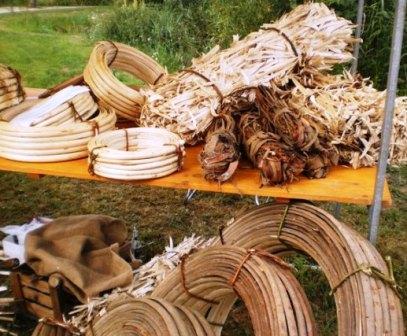Use long nettles with a thick stem and remove the leaves. Crush the stems (between thumb and fingers or sticks, stones) until the stem is completely flat. Carefully break the stem at the base. The fibers are visible and come off of the stiff core. Carefully pull the bark of the stem. In addition, try to keep the fibers as long and wide as possible.
Let the fibers dry up. Too dry fiber you need to moisten them a little bit again before twisting them.
You can strip or scrape the wire fibers from the stem and rib of the horseradish leaf and dry for strong, stiff rope. (Your hands will stink for days.)
Hand turning
 Take a bundle of fibers and twist the ends in opposite directions. Keep going on until the beam curls in the middle and the two threads thereby rotate around each other. You are actually simultaneously spinning and twisting. In the center form the first strokes. Clamp the first strokes somewhere (knees, teeth..) and stay fixed on rotating (spinning) both ends. Add new fibers in time in order to keep the thickness and strength of the rope equal, and to make the rope longer.
Take a bundle of fibers and twist the ends in opposite directions. Keep going on until the beam curls in the middle and the two threads thereby rotate around each other. You are actually simultaneously spinning and twisting. In the center form the first strokes. Clamp the first strokes somewhere (knees, teeth..) and stay fixed on rotating (spinning) both ends. Add new fibers in time in order to keep the thickness and strength of the rope equal, and to make the rope longer.
Another method is to roll up your thigh. Take two strands and lay them parallel on your thigh. Hold with one hand the ends of two strands fixed. Roll with your other hand on the strings so that the fibers twist around each other (spinning). Repeat until the strands through the accumulated torsion curl around each other. Add also timely fiber strands to make the rope long, smooth thick and firmly.
Nature provides a lot of material that is suitable to make rope.
Stems: nettle (Urtica), bulrush (Scirpus), blackberry (Rubus), hemp (Cannabis), spear thistle (Cirsium vulgare), fireweed (Epilobium angustifolium), evening primrose (Oenothera)
The best bark strap material comes from thin branches. Cortex is thinner. Use walnut (Juglans), lime (Tilia Genus), willow (Salix Genus), ash (Fraxinus), elm (Ulmus), cherry (Prunus), cedar (Cedrus), chestnut (Castanea sativa), maple (Acer) eastern cottonwood (Populus deltoides), oak (Quercus)
The best roots can be found close to the surface. Thicker you can split. Use larch (Larix laricina), pine (Pinus sylvestris), cedar (Cedrus), conifer (Juniperus), spruce (Picea), sage (salvia), alder (Alnus), birch (Betula)
Of linden (Tilia) was the fibrous structure of the bark used for carpets (mats) and later also for paper. It was used as a rope and tie bark for binding sheaves and brooms.
Leafs: reed (Phragmites australis), sweetgrass (Hierochloe), cattail (Typha), (blue or tall) sedge (Carex), couch grass (Elytrigia repens)
Thin shoots of birch and hazel, and cleft blackberry are directly suitable as a string.
In animal material horsehair, skin, tendon and intestinal fit.
A tendon is a tough, non-stretchable, strong strand or band of fibrous connective tissue between muscle and bone, with which muscle activity is transferred to the bone. You see and feel them in the back of your hand. Very well known is the achilles back over your heel. This is also the longest string.
Tendon can be used for bow strings, securing arrowheads, fishing lines, binding equipment, traps and yarn. If you make them wet they dry as hard as glue. Nodes is not necessary.
A dry tendon is hard and brittle. With a rock, you can hit the fibers loose. They are useful if you soak them in warm water.
A bull pizzle is half whip and half stick, actually the dried penis of a bull. A bull pizzle is at least 75-85 cm long. (A whip has a supersonic bang. The end goes through the sound wall, and therefore goes faster than the sound.)
